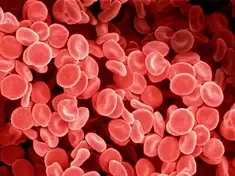|
Introduction
|
|
Where roughly 95% of all blood cells are produced
|
Bone Marrow
|
|
The measure of the force that the heart uses to pump blood around the body
|
Blood Pressure
|
|
Blood itself is a liquid ______
|
Tissue
|
|
Pathology
|
|
Most common blood cancer; formed in bone marrow and then expands into the blood
|
Leukemia
|
|
Cancer in the lymphatic system, which WBCs are a part of
|
Lymphoma
|
|
Cancer that starts in the bone marrow and affects the plasma cells
|
Myeloma
|
|
Condition where the body doesn't produce enough platelets (less than 150,000 platelets per microliter)
|
Thrombocytopenia
|
|
Too high platelet counts (more than 450,000 platelets per microliter)
|
Thrombocytosis
|
|
When the blood carries less oxygen than normal; will cause coldness, tiredness and weakness
|
Anemia
|
|
When your WBC count is too low (>4,000 per microliter of blood)
|
Leukopenia
|
|
When the body produces too many WBCs (>11,000 per microliter of blood)
|
Leukocytosis
|
|
One or more structures in the heart is irregular due to not properly forming during fetal development
|
Congenital heart disease
|
|
Low oxygen level in the blood
|
Hypoxia
|
|
The condition where the body's neutrophilia count is too high, can be identified if you have more than 7,500 neutrophils per microliter
|
Neutrophilia
|
|
The condition where the body's neutrophil count is too low; making it harder for the immune system to fight off infections and bacteria
|
Neutropenia
|
|
When the body's reaction to an infection becomes extreme and the immune system starts attacking normal, healthy organs instead, and in this case, the infection pertains the the blood itself. This illness is often referred to as blood poisoning
|
Sepsis
|
|
|
Red Blood Cells
|
|
Scientific name
|
Erythrocytes
|
To carry essential substances such ______ to the body's cells and tissues. And as the oxygen is sued to convert into energy, the tissues will then release ______ _________, and the red blood cells carry this out from the body |
Oxygen
|
|
Carbon Dioxide
|
|
The production of RBCs will take roughly _ days
|
7
|
|
RBCs get their red colour from this protein within the RBCs, and this protein is also what allows RBCs to carry essential substances such as oxygen around the body
|
Hemoglobin
|
|
Unlike most cells, RBCs doesn't have any ________, which also allows them to move around easier
|
Nucleus
|
|
The name of the process when RBCs are produced
|
Erythropoiesis
|
|
The average life-span of red blood cells
|
120 Days
|
|
White Blood Cells
|
|
Scientific name
|
Leukocytes
|
|
WBCs are part of the ______ system that protects the body from __________
|
Immune
|
|
Infections
|
|
The WBCs protects the body by attack and destroy foreign _________ that enters the body
|
Organisms
|
|
WBCs will surround and destroy the the organisms by ingesting it with ________ that will kill the organisms from the inside
|
Enzymes
|
|
Help protect your body from infections by killing bacteria, fungi and foreign debris
|
Neutrophils
|
|
Identify and destroy parasites, cancer cells and assists with allergic responses
|
Eosinophils
|
|
Produce an allergic response like coughing, sneezing or a runny nose
|
Basophils
|
|
Consists of _-cells (natural killer cells; matures in the thymus gland) and _-cells (protects against viral infections and produce proteins to help fight infection; matures in the lymph nodes and spleen)
|
T
|
|
B
|
|
Defend against infection by cleaning up damaged cells
|
Monocytes
|
|
|
Platelets
|
|
Scientific name
|
Thrombocytes
|
|
The platelets are the ________ component of the blood
|
Smallest
|
|
Platelets control bleeding, by cluster together to form a ____, and this ____ will seal the damaged blood vessels to stop the bleeding
|
Clot
|
|
Platelets form in the shape of a _____
|
Plate
|
|
The colour of platelets
|
Colourless
|
When platelets extend to stop the bleeding, the platelets will extend filaments that resemble legs on a _______ |
Spider
|
|
Platelets are produced by the largest cells in the bone marrow
|
Megakaryocytes
|
|
Plasma
|
|
The plasma accounts for roughly 55% of the blood's total volume and is the ______ component of the blood
|
Liquid
|
|
As an embryo, the cells in the _________ cord will produce plasma cells. After development, plasma proteins form in the bone marrow, liver cells, blood cells at the end of their lifespan and in the spleen
|
Umbilical
|
|
Plasma has the colour of light ______, but the colour of red blood cells will suppress the visibility of plasma whilst merged
|
Yellow
|
The components of Plasma
1. Composed of hydrogen and oxygen 2. Proteins 3. Liquefied salts and minerals that carry electrical charges 4. Components that help fight infections
|
Water
|
|
Albumin
|
|
Fibrinogen
|
|
Globulin
|
|
Electrolytes
|
|
Immunoglobulins
|
|

